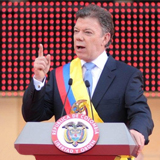August 10 provided a great photo opportunity for both Colombia’s new president, Juan Manuel Santos, and his Venezuelan counterpart, Hugo Chavez, each smiling and jovial. Meeting in the Colombian city of Santa Marta, the two leaders agreed to restore diplomatic ties, which were severed earlier in the summer after Santos’s predecessor, Alvaro Uribe, accused Venezuela of harboring left-wing Revolutionary Armed Forces of Colombia (FARC) rebels.
But smoothing Colombia’s relationship with its feisty Andean neighbor hasn’t been the only item on Santos’s agenda since being elected in a landslide victory in June and inaugurated in early August. Santos won June’s run-off election amid promises to voters he’d attack Colombia’s deep social problems, which are widely believed to be root cause of the violence and criminality that have plagued this country for decades. Since his inauguration in August, he has begun acting on those promises, rolling out an ambitious slate of proposals.



